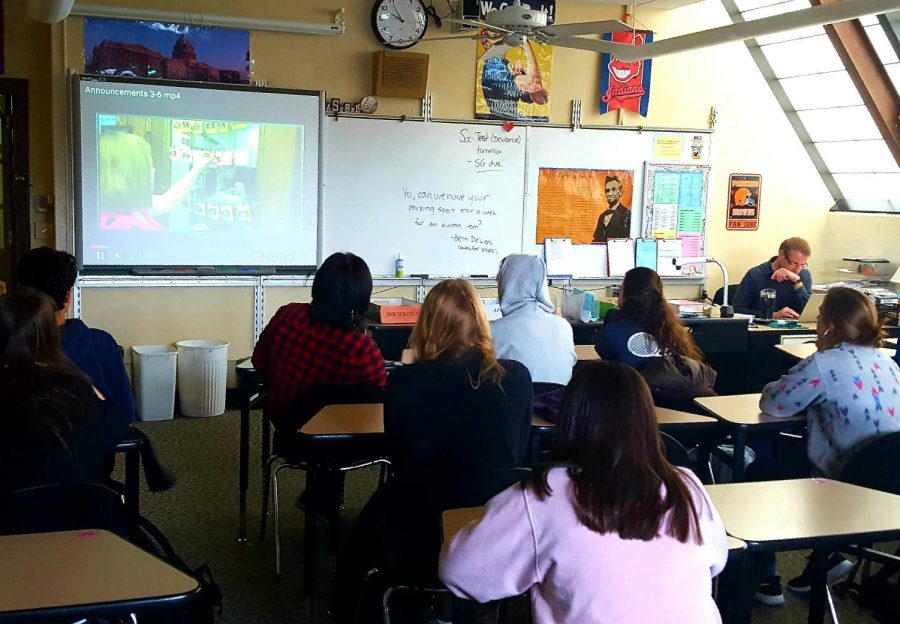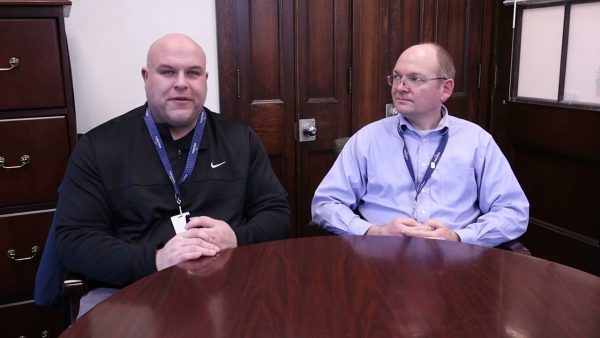Home sweet homeroom
Examining the process behind the Wednesday schedule and how students feel about it
Mid-week update: Sophomore students in AP U.S. History and Sociology teacher John Moore’s homeroom watch the announcements before participating in the day’s scheduled activity.
Every Wednesday, students and teachers take 21 minutes out of their day to participate in homeroom. Based on the Search Institute’s 40 Developmental Assets, the weekly program focuses on
improving healthy relationships between every student and their community, school, and family.
Guidance counselor Joan Bline, an adviser for homeroom, has created the 40 Assets Homeroom club for students to help incorporate these goals into homeroom and give their opinions on activities.
“I’ve been meeting with them for years, and they have a very active role in helping design some of these programs,” Bline said. “We have consistently involved students at a variety of different levels.”
This year, the club has decided to try something new throughout the grade levels.
“We have done a variety of surveys over the years to staff and kids to get their feedback, but this year we decided that we would focus on four themes when possible,” Bline said. “Freshman year is ‘transitioning in’, so we’ve had activities that deal with how to transition into high school. Sophomore year is ‘making connections’, junior year is ‘building character’, and senior year is ‘transitioning out’ since a lot of what happens as a senior is the college process.”
However, there appears to be an inconsistency between the feedback from students in the club and the responses of the students who responded to the survey sent out in regards to the topics discussed during homeroom.
“I definitely think sometimes they kind of miss what we really feel are issues and focus on what they think are issues,” Sydney Hardern (11) said. “I wish that there was some more about stress-managing tactics, I wish maybe it functioned more as a study hall.”
Out of 38 students who responded to a poll by Ax Media, seven mentioned stress management or mental health as a topic they would like to see more often discussed in homeroom.
Perhaps it is necessary to find a balance between what the students and the staff find important to teach, according to Bline.
“I do think it’s important that adults present topics that they think are pertinent into kids’ lives,” Bline said. “But at the same time, we’re not teenagers, so we need to hear from you all, we need to have teenagers help shape our program.”
Another response seen frequently in the survey that Ax Media sent out to students was that they would like to see more about current events or happenings around the school.
“I think it should be more about going over school events for the week, like letting people know about fire drills, sports events, etc.,” Gwen Reichert (11) said in the online survey.
Additionally, students exhibited concerns over whether homeroom is effective for class bonding. Many students who responded to the survey said that they enjoyed or would like to see more whole class bonding activities, but some were unsure if it could be developed in the time frame given.
“I really don’t think it is effective for class bonding since it is only a small amount of time taken out of each week,” Jordan Neeley (12) said in the survey. “I think if we want to spend time bonding with our classmates we should have a day like freshman challenge for all of the grades once or twice a year to bond together.”
Others believe that the students are already close to each other, and that homeroom can’t do much to change their relationships.
“Because these students already know each other, homeroom doesn’t necessarily bring people who don’t spend time with each other together,” Sam Miller (12) said. “It rather just lets people who already know each other spend time together.”
Ultimately, according to Bline, it’s up to the students.
“We do what we can to do activities that we hope are meaningful and that we hope can engage, but a lot of it really comes down to the kids,” Bline said. “You’ve got to want to do them. There’s a lot more positive support and feedback from the kids, so we do feel like the program is moving forward, but we want to constantly reevaluate and do what we can to make it the best program possible.”
Participation may also vary from class to class and from teacher to teacher.
“Right now I have a senior homeroom, and the past four years they have been very positive about the homeroom experience,” Melinda Wargacki, a biology and forensic sciences teacher as well as a homeroom adviser, said. “They never have a problem with what we’re doing, but I can only speak for my homeroom.”
Bline acknowledges the importance of students’ voices in shaping the program. Students who have suggestions or ideas for homeroom can speak to advisers Bline, Wargacki, or English teacher Amy Ostdiek, or attend one of the monthly meetings of the 40 Assets Homeroom club.







